Why you should see ‘641 Muriel Court’
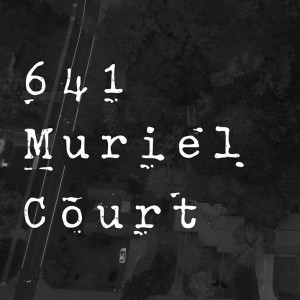 641 Muriel Court is a documentary about an unsolved triple murder that occurred in Tallahassee, Florida on the night of October 22, 1965. Last year, four Florida State University students decided to probe the cold case for a 35-minute first cut they were shooting for Professor Brian Grave’s Spring semester documentary film course. The project took on a life of its own that extended well beyond the end of the semester, but the foursome vowed at the outset that if they were going to undertake the project at all, they had to follow it
641 Muriel Court is a documentary about an unsolved triple murder that occurred in Tallahassee, Florida on the night of October 22, 1965. Last year, four Florida State University students decided to probe the cold case for a 35-minute first cut they were shooting for Professor Brian Grave’s Spring semester documentary film course. The project took on a life of its own that extended well beyond the end of the semester, but the foursome vowed at the outset that if they were going to undertake the project at all, they had to follow it 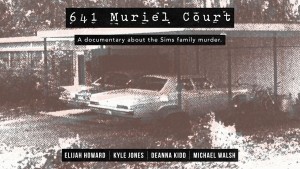 wherever and however long it took “because of how much the story means to a lot of people.” The result is a 61-minute documentary that has garnered Kyle Jones, Elijah Howard, Deanna Kidd and Michael Walsh rock star status on campus, considerable attention elsewhere, admission into the Fort Myers Film Festival and first place at the
wherever and however long it took “because of how much the story means to a lot of people.” The result is a 61-minute documentary that has garnered Kyle Jones, Elijah Howard, Deanna Kidd and Michael Walsh rock star status on campus, considerable attention elsewhere, admission into the Fort Myers Film Festival and first place at the 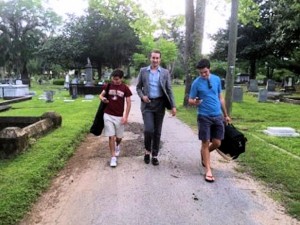 Broadcast Education Association (BEA) Student Documentary Competition.
Broadcast Education Association (BEA) Student Documentary Competition.
Jones served as director and collaborated with Howard, Kidd and Walsh to write and produce the film. Together, they logged uncounted hours doing research, poring over documents, cold calling leads, conducting interviews, assembling storyboards and editing film footage. Brittany 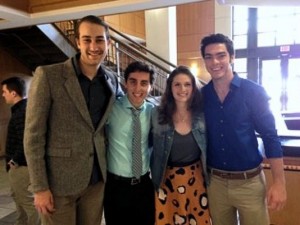 Drotleff and Drextson Redway did graphic design for the film.
Drotleff and Drextson Redway did graphic design for the film.
On the night in question, the FSU Seminoles was playing a home game against the Mississippi State Bulldogs. Robert and Helen Sims were enjoying a Saturday night with their 12-year-old daughter, Joy, in their brick ranch house at 641 Muriel Court. Two older daughters, Jeanie (17) and Judy (16), 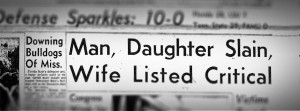 were out babysitting. Jeanie was first to return home that night. She opened the door around 11 p.m. on a grisly scene. Her father and little sister lay dead. Her mother was barely clinging to life, and would succumb to her
were out babysitting. Jeanie was first to return home that night. She opened the door around 11 p.m. on a grisly scene. Her father and little sister lay dead. Her mother was barely clinging to life, and would succumb to her 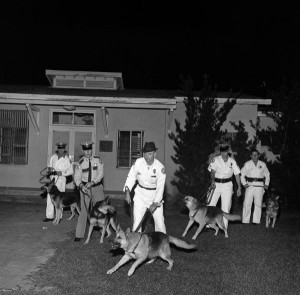 wounds a few days later.
wounds a few days later.
Although the police questioned dozens of people and produced thousands of documents, no one was ever charged with the murders. Jones obtained many of those documents from author and long-time Sims’ researcher Henry Cabbage, who delivered reams of records to Jones in box labeled “Sims murders” on the side in black marker. The meet appropriately took place in a small, dimly-lit bar right out of a film noir movie.
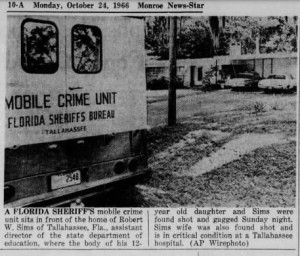 Jones, Howard, Kidd and Walsh waded through the sheaths of documents Kyle obtained from Cabbage, working into the summer to produce an expanded version of the 35-minute rough cut they turned in for credit at the end of the Spring semester. And then something unexpected happened. Jones landed an interview with one of the original suspects in the case. His name is Vernon Fox, and he had a lot to say about the case. “That was a very, very interesting interview with very interesting
Jones, Howard, Kidd and Walsh waded through the sheaths of documents Kyle obtained from Cabbage, working into the summer to produce an expanded version of the 35-minute rough cut they turned in for credit at the end of the Spring semester. And then something unexpected happened. Jones landed an interview with one of the original suspects in the case. His name is Vernon Fox, and he had a lot to say about the case. “That was a very, very interesting interview with very interesting 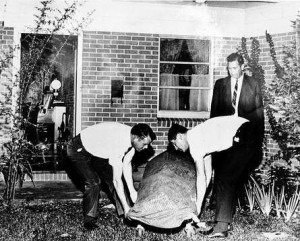 material,” Kyle says, reflecting back on the meeting.
material,” Kyle says, reflecting back on the meeting.
In addition to Fox, 641 Muriel Court contains footage of interviews with Cabbage, retired Tallahassee Democrat columnist and local historian Gerald Ensley, a funeral director by the name of Rocky Bevis (one of the first people on the scene), and State Attorney Willie Meggs, then a Tallahassee Police Department traffic officer.
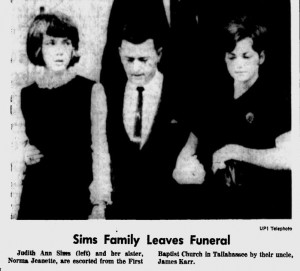 “We honestly felt like we were doing some investigative journalism at some points,” Kyle told FSU News Staff Writer Miranda Lensky last October. “We even have never-before-seen material that even police might want, which makes us feel very much a part of it, which is cool.”
“We honestly felt like we were doing some investigative journalism at some points,” Kyle told FSU News Staff Writer Miranda Lensky last October. “We even have never-before-seen material that even police might want, which makes us feel very much a part of it, which is cool.”
Jones acknowledges that the question he’s asked most is whether he and his teamed solved the crime. “We leave out any speculation and we provide the facts so that the audience can decide for 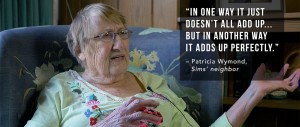 themselves,” he responds. That said, he concedes that the documentary takes a clear stance on who committed the triple homicide. Hint: 25 of the 61 minute documentary is spent just talking to the prime suspects.
themselves,” he responds. That said, he concedes that the documentary takes a clear stance on who committed the triple homicide. Hint: 25 of the 61 minute documentary is spent just talking to the prime suspects.
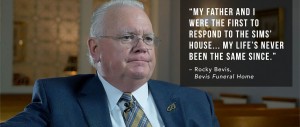 But whether he and his filmmaking team have solved the crimes is moot. In fact, that was never their intent. Rather, the point of the documentary was to accurately delineate the historical record of a crime that took three lives, altered innumerable others and permanently
But whether he and his filmmaking team have solved the crimes is moot. In fact, that was never their intent. Rather, the point of the documentary was to accurately delineate the historical record of a crime that took three lives, altered innumerable others and permanently 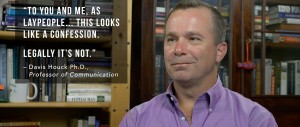 changed the city of Tallahassee, which was so safe and small town at the time that few people locked their doors (even when they went away on vacation) and had no 911 or EMS service.
changed the city of Tallahassee, which was so safe and small town at the time that few people locked their doors (even when they went away on vacation) and had no 911 or EMS service.
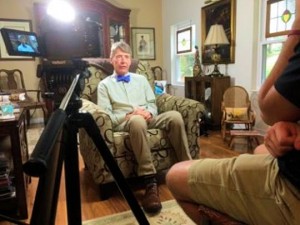 “Being the first people to sit down and attempt to do what no one else has been able to do says a lot about 641 Muriel Court,” Kyle said in the FSU News interview.
“Being the first people to sit down and attempt to do what no one else has been able to do says a lot about 641 Muriel Court,” Kyle said in the FSU News interview.
The BEA competition is the world’s largest digital media and broadcast competition for students and faculty. 641 Muriel Court was awarded first place in the Long Form Video category among 175 entries.
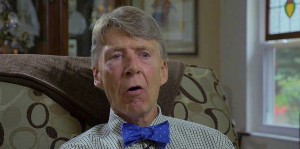 641 Muriel Court will be screened at 4:30 p.m. on Thursday, March 9 in the grand atrium of the Sidney & Berne Davis Art Center.
641 Muriel Court will be screened at 4:30 p.m. on Thursday, March 9 in the grand atrium of the Sidney & Berne Davis Art Center.
March 5, 2017.
RELATED POSTS.
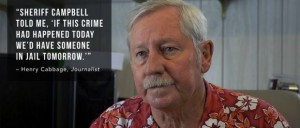 Overview of the 7th Annual Fort Myers Film Festival
Overview of the 7th Annual Fort Myers Film Festival- Why you should see ‘Paradise Reef’
- Meet ‘Paradise Reef’ writer and director John Scoular
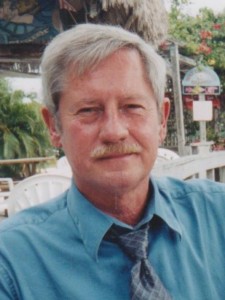 A word or two about Everglades fine art photographer Clyde Butcher
A word or two about Everglades fine art photographer Clyde Butcher- Meet ‘Paradise Reef’ cinematographer and commentator Andy Brandy Casagrande IV
- A look back at John Scoular documentary ‘Marcus Jansen: Examine & Report’
- Lake O discharge documentary, ‘Black Tide,’ to open Fort Myers Film Festival
- Meet ‘Black Tide’ writer, director and producer Steven Johnson
- Read what ‘Black Tide’ filmmaker Steven Johnson has to say about his documentary
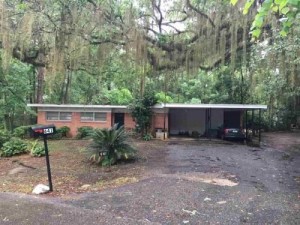 How the Everglades, Caloosahatchee and St. Lucie got so bad
How the Everglades, Caloosahatchee and St. Lucie got so bad- Why you should see ‘Bubbles’
- How ‘Bubbles’ got made
- Meet ‘Bubbles’ screenwriter and maniacal clown Cesar Aguilera
- Why you should see ‘Naked Problems’
- What writer-director-sculptor AR Kara has to say about ‘Naked Problems’
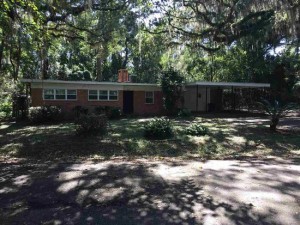 Why you should see ‘The Radical Jew’
Why you should see ‘The Radical Jew’- ‘Radical Jew’ awards and accolades
- Why you should see ‘The Stairs’
- Why the filmmakers made ‘The Stairs’
- Why you should see ‘Three Wishes’ at this year’s Fort Myers Film Festival
- Meet ‘Three Wishes’ writer, director and producer Curtis Collins














 Tom Hall is both an amateur artist and aspiring novelist who writes art quest thrillers. He is in the final stages of completing his debut novel titled "Art Detective," a story that fictionalizes the discovery of the fabled billion-dollar Impressionist collection of Parisian art dealer Josse Bernheim-Jeune, thought by many to have perished during World War II when the collection's hiding place, Castle de Rastignac in southern France, was destroyed by the Wehrmacht in reprisal for attacks made by members of the Resistance operating in the area. A former tax attorney, Tom holds a bachelor's degree as well as both a juris doctorate and masters of laws in taxation from the University of Florida. Tom lives in Estero, Florida with his fiancee, Connie, and their four cats.
Tom Hall is both an amateur artist and aspiring novelist who writes art quest thrillers. He is in the final stages of completing his debut novel titled "Art Detective," a story that fictionalizes the discovery of the fabled billion-dollar Impressionist collection of Parisian art dealer Josse Bernheim-Jeune, thought by many to have perished during World War II when the collection's hiding place, Castle de Rastignac in southern France, was destroyed by the Wehrmacht in reprisal for attacks made by members of the Resistance operating in the area. A former tax attorney, Tom holds a bachelor's degree as well as both a juris doctorate and masters of laws in taxation from the University of Florida. Tom lives in Estero, Florida with his fiancee, Connie, and their four cats.